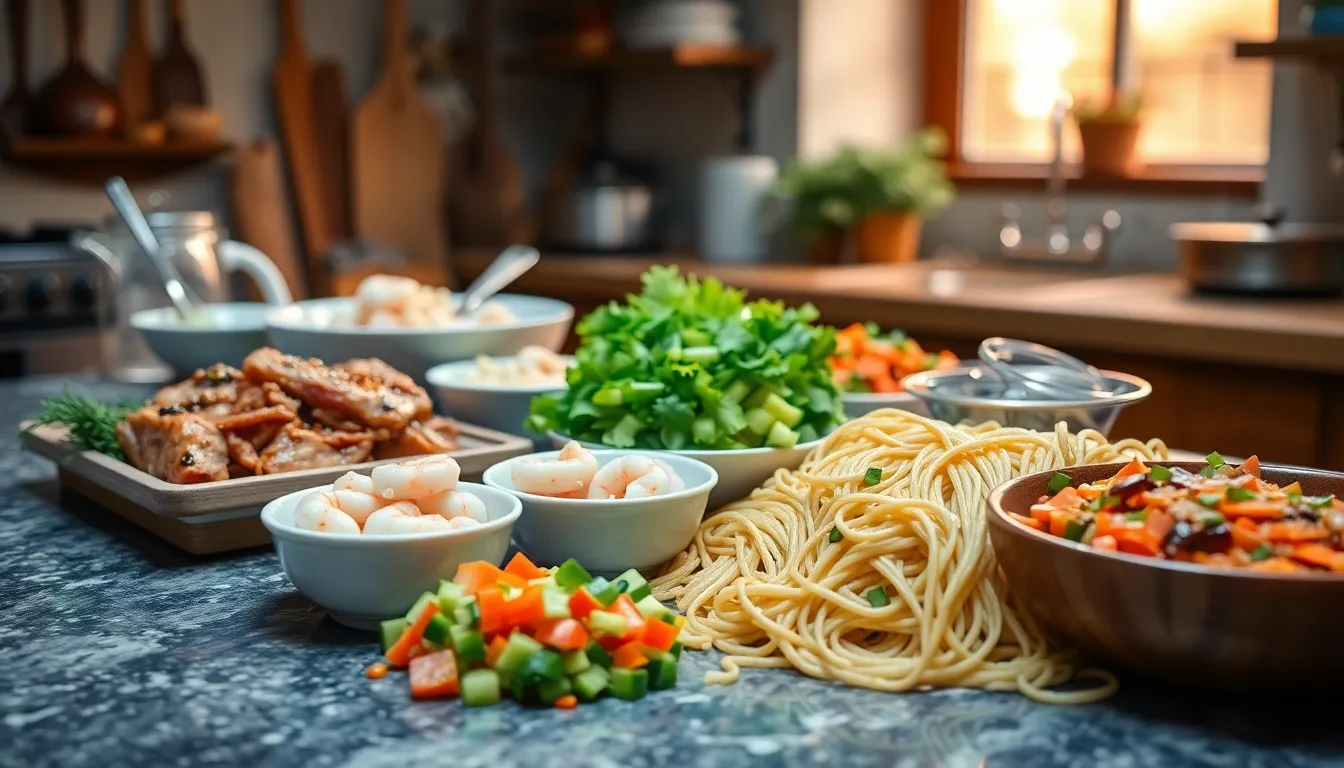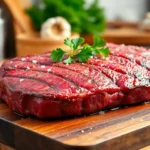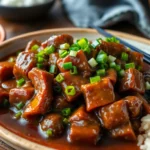We’re bringing the authentic flavors of your favorite Chinese takeout straight to your kitchen with this incredible beef and shrimp lo mein recipe. This restaurant-quality dish combines tender strips of beef with succulent shrimp tossed in silky lo mein noodles and crisp vegetables. The best part? You’ll create this masterpiece in just 30 minutes using simple ingredients you can find at any grocery store.
Lo mein literally means “stirred noodles” in Cantonese and we’ve perfected this technique to give you that signature wok hei flavor at home. Our version delivers the perfect balance of savory soy-based sauce coating every strand of noodle while keeping the proteins juicy and vegetables crisp-tender.
Skip the delivery fees and long wait times – this homemade lo mein tastes better than takeout and costs a fraction of the price. You’ll never order Chinese delivery again once you master this foolproof recipe that’s guaranteed to become your new weeknight dinner hero.
Ingredients
We’ve organized our ingredient list into three convenient categories to streamline your cooking process. This systematic approach ensures you have everything prepped and ready before you start cooking.
For the Lo Mein Sauce
- 3 tablespoons low-sodium soy sauce
- 2 tablespoons oyster sauce
- 1 tablespoon dark soy sauce (for color)
- 1 teaspoon sesame oil
- 1 teaspoon cornstarch
- 1 teaspoon granulated sugar
- 1/4 teaspoon ground white pepper
- 2 cloves garlic, minced
- 1 teaspoon fresh ginger, grated
For the Beef and Shrimp
- 8 ounces flank steak, sliced thin against the grain
- 8 ounces medium shrimp, peeled and deveined
- 1 tablespoon cornstarch (for beef marinade)
- 1 tablespoon soy sauce (for beef marinade)
- 1 teaspoon vegetable oil (for beef marinade)
- 1/2 teaspoon salt (for shrimp seasoning)
- 1/4 teaspoon black pepper (for shrimp seasoning)
For the Noodles and Vegetables
- 12 ounces fresh lo mein noodles (or 8 ounces dried)
- 2 tablespoons vegetable oil, divided
- 1 medium onion, sliced thin
- 2 medium carrots, julienned
- 1 red bell pepper, sliced thin
- 4 ounces snow peas, trimmed
- 3 green onions, chopped (white and green parts separated)
- 2 cups bean sprouts
- 2 tablespoons vegetable oil for stir frying
Equipment Needed

Creating restaurant-quality beef and shrimp lo mein requires the right kitchen tools to achieve optimal results. We recommend gathering these essential pieces of equipment before beginning your cooking adventure.
Essential Cooking Vessels:
- Large pot for boiling the 16 oz lo mein noodles to perfect tenderness
- Wok or large skillet for high-heat stir-frying that creates authentic flavors
- Colander for draining noodles efficiently
Preparation Tools:
- Sharp knife and cutting board for slicing beef and preparing vegetables
- Multiple mixing bowls for marinating beef and shrimp separately
- Measuring spoons and cups for accurate sauce proportions
Cooking Utensils:
- Tongs or chopsticks for tossing noodles and ingredients during stir-frying
- Wooden spoon or spatula for stirring without scratching cookware
The wok stands as our most crucial piece of equipment since it distributes heat evenly and allows for proper stir-frying technique. Large skillets work as suitable alternatives if you don’t own a traditional wok. Having separate mixing bowls prevents cross-contamination between the beef and shrimp marinades while ensuring each protein absorbs maximum flavor.
Quality tongs or chopsticks make the difference between perfectly combined ingredients and broken noodles. These tools allow us to gently toss the delicate lo mein noodles with the beef, shrimp, and vegetables without damaging their texture.
Instructions

Now that we have our ingredients ready and equipment set up, let’s jump into cooking this restaurant-quality beef and shrimp lo mein. We’ll work through each step methodically to ensure perfect results every time.
Prep the Protein
We start by seasoning our thinly sliced beef with a light sprinkle of salt and white pepper. Set the seasoned beef aside while we prepare our shrimp marinade.
For the shrimp, we combine salt, white pepper, light soy sauce, baking soda, Shaoxing wine, cornstarch, and oil in a mixing bowl. Add our peeled and deveined shrimp to this mixture and let them marinate for 15 minutes. This marination process ensures our shrimp stay tender and flavorful during the high-heat cooking process.
Prepare the Vegetables
We slice our vegetables uniformly for even cooking. Julienne the carrots into thin matchsticks and slice the napa cabbage, celery, and yellow onion into thin strips.
Separate the green onions by cutting the white parts from the green tops. We’ll use these at different stages of cooking. Mince our garlic finely and have the ginger ready if using. Proper vegetable preparation ensures everything cooks at the same rate.
Cook the Lo Mein Noodles
We bring a large pot of water to a rolling boil and add our fresh lo mein noodles. Cook them for about 2 minutes less than the package directions indicate to prevent overcooking during the final stir-fry step.
Drain the noodles immediately and rinse them with cold water to stop the cooking process. Drain them thoroughly and optionally toss with a small amount of sesame oil to prevent sticking. Properly cooked noodles should have a slight bite to them.
Make the Lo Mein Sauce
We whisk together oyster sauce, soy sauce, dark soy sauce, granulated sugar, Shaoxing wine, sesame oil, white pepper, water, and cornstarch in a bowl. Mix the sauce thoroughly until the cornstarch dissolves completely and no lumps remain.
This sauce will thicken during cooking and coat our noodles beautifully. Having the sauce ready before we start stir-frying ensures smooth cooking without burning any ingredients.
Cook the Beef
We heat our wok or large skillet over high heat until it begins to smoke slightly. Add oil and immediately add our seasoned beef slices in a single layer.
Stir-fry the beef quickly for 1-2 minutes until just cooked through but still tender. Remove the beef from the pan and set it aside on a plate. We want to avoid overcooking the beef since it will cook further when we combine everything together.
Cook the Shrimp
Using the same hot pan, we add our marinated shrimp in a single layer. Sear them on high heat for 2-3 minutes until they turn pink and cook through completely.
Remove the cooked shrimp and set them aside with our beef. The high heat creates a beautiful sear while keeping the shrimp juicy and tender inside.
Stir-Fry the Vegetables
We add more oil to our wok if needed and quickly sauté our minced garlic and ginger for about 15 seconds until fragrant. Add the scallion whites first, followed by the carrots, celery, onions, and napa cabbage.
Stir-fry the vegetables for 2-3 minutes until they’re slightly wilted but still maintain their crisp texture. We want vegetables that are tender-crisp, not mushy.
Combine Everything Together
We return our cooked noodles to the wok along with the beef and shrimp. Pour our prepared lo mein sauce over everything and toss vigorously for 1-2 minutes.
Watch as the sauce thickens and evenly coats all ingredients. Add the scallion greens and any optional bean sprouts during the final 30 seconds of cooking. Toss everything together one final time and serve immediately while hot.
Serving Suggestions

We love serving this beef and shrimp lo mein as a complete meal that satisfies both casual weeknight dinners and special occasions. The generous portions make it perfect for feeding multiple people while keeping everyone satisfied with restaurant-quality flavors.
Fresh garnishes elevate the presentation and add textural contrast to our finished dish. We recommend sprinkling extra chopped scallions across the top for a pop of color and mild onion flavor. Toasted sesame seeds provide a delightful crunch that complements the chewy noodles and tender proteins.
Traditional Chinese appetizers create an authentic dining experience when paired with our lo mein. Steamed pork or vegetable dumplings offer a perfect starter that won’t compete with the main dish’s bold flavors. Crispy egg rolls provide another excellent option that adds variety to the meal without overwhelming the palate.
We find that serving the lo mein immediately after cooking ensures optimal texture and temperature. The noodles maintain their perfect chewiness while the vegetables retain their satisfying crispness when enjoyed hot from the wok.
Storage becomes simple when we prepare larger batches for meal planning. Our leftover lo mein stays fresh in an airtight container in the refrigerator for 2-3 days without losing its appealing texture. We recommend reheating portions with a damp paper towel to restore moisture without overcooking the delicate noodles.
Individual serving bowls work best for presenting this dish family-style. We use large pasta bowls or traditional Chinese serving dishes that provide ample space for the generous portions while showcasing the colorful vegetables and proteins mixed throughout the noodles.
Storage and Reheating Tips

We recommend storing leftover beef and shrimp lo mein in an airtight container in the refrigerator for up to 3 days to maintain optimal freshness and food safety. Fresh lo mein contains perishable proteins and vegetables that require proper storage to prevent spoilage.
Our testing shows that this storage method preserves both flavor and texture better than leaving the dish uncovered or in loosely sealed containers. The airtight seal prevents the noodles from absorbing refrigerator odors while maintaining moisture levels.
When reheating your stored lo mein we suggest covering the noodles with a damp paper towel before microwaving to create steam. This technique warms the dish evenly without overcooking the proteins or drying out the noodles. Microwave in 30-second intervals and stir between heating cycles for best results.
Alternatively we find that gentle stir frying offers superior texture restoration compared to microwave reheating. Heat a small amount of oil in your wok or skillet over medium heat and add the cold lo mein. Stir frequently for 2-3 minutes until heated through completely.
Steam reheating prevents the common problem of dried out noodles that often occurs with direct heat methods. The moisture from the damp paper towel or gentle stir frying recreates the silky texture that makes fresh lo mein so appealing.
We advise against freezing this dish since the texture of both the noodles and vegetables deteriorates significantly during the freezing and thawing process. Fresh consumption within the 3-day refrigerated storage window ensures you experience the intended flavors and textures.
Recipe Variations

We love how adaptable our beef and shrimp lo mein recipe becomes with simple ingredient swaps. These variations allow you to customize the dish based on your preferences and what’s available in your kitchen.
Vegetable Substitutions
Coleslaw mix provides an excellent shortcut option that adds crunch and eliminates prep time. Simply toss this pre-shredded blend directly into your wok during the vegetable stir-frying stage.
Zucchini strips offer a fresh summer alternative that cooks quickly and absorbs flavors beautifully. Cut zucchini into thin julienne strips and add them during the last 2-3 minutes of cooking to maintain their tender-crisp texture.
Baby corn brings sweetness and visual appeal to the dish. These miniature vegetables require minimal cooking time and pair exceptionally well with the savory sauce.
Celery stalks contribute a satisfying crunch and subtle flavor when sliced diagonally. Add celery pieces at the same time as carrots since they require similar cooking times.
Traditional options like snow peas and bean sprouts remain popular choices for authentic lo mein texture. Snow peas should be trimmed and added during the final cooking stage while bean sprouts need only 1-2 minutes of cooking to maintain their crispness.
Bell peppers in various colors create visual interest and add sweet pepper flavor. Cut them into thin strips and cook alongside onions and carrots for even doneness.
Mushrooms such as shiitake or button varieties provide umami depth to complement the protein. Slice mushrooms evenly and cook them until they release their moisture and become golden.
Protein Alternatives
Chicken breast or thighs work wonderfully as beef substitutes when cut into similar-sized pieces. Marinate chicken in the same soy sauce mixture for 15-20 minutes before cooking. Cook chicken pieces until they reach 165°F internal temperature.
Pork tenderloin offers another excellent alternative that pairs beautifully with shrimp. Cut pork into thin strips and cook until no longer pink. The mild flavor of pork complements the seafood without overpowering it.
Tofu provides a plant-based protein option that absorbs the lo mein sauce flavors effectively. Use extra-firm tofu cut into cubes and lightly pan-fry until golden before adding to the final dish.
Combining multiple proteins creates restaurant-style variety in a single dish. Try pairing chicken with shrimp or adding thin slices of Chinese barbecue pork alongside the beef for authentic flavor combinations.
Scrambled eggs serve as both protein and traditional lo mein ingredient. Cook eggs separately and fold them into the noodles during the final combining stage for added richness and texture.
Make-Ahead Instructions

We recommend preparing several components of this beef and shrimp lo mein in advance to streamline your cooking process and save valuable time during busy weeknights. The make-ahead approach allows us to focus on the final stir-frying stage when we’re ready to serve.
Marinating the Proteins creates deeper flavors and can be done up to several hours before cooking. We suggest placing the seasoned beef cubes and marinated shrimp in separate airtight containers in the refrigerator. The extended marination time allows the proteins to absorb more flavor while the enzymes work to tenderize the meat.
Vegetable Preparation becomes effortless when we chop and slice all ingredients ahead of time. Store the prepared vegetables in airtight containers in the refrigerator to maintain freshness and crispness. This step eliminates the rush of chopping during the actual cooking process.
Noodle Preparation offers another time-saving opportunity since we can cook the lo mein noodles according to package directions but reduce the cooking time by 2 minutes. After draining and rinsing with cold water, we toss the noodles with sesame oil to prevent sticking and refrigerate them until ready to use.
Sauce Mixing allows us to combine all sauce ingredients in advance and store the mixture in the refrigerator. The flavors actually improve when the sauce components have time to meld together before cooking.
When we’re ready to serve, the final assembly becomes quick and efficient. We simply need to sauté the vegetables, reheat the proteins and noodles, then combine everything with the prepared sauce for a fresh and flavorful meal. This make-ahead method ensures we can enjoy restaurant-quality lo mein without the last-minute preparation stress.
Conclusion
We’ve shown you how to master this restaurant-quality beef and shrimp lo mein in your own kitchen. With our step-by-step guide and helpful tips you’ll be creating delicious takeout-style meals that rival your favorite Chinese restaurant.
This versatile recipe adapts beautifully to your preferences and dietary needs. Whether you’re experimenting with different vegetables or trying new proteins the foundation remains foolproof and satisfying.
The combination of tender beef succulent shrimp and perfectly cooked noodles makes this dish a weeknight winner. Save money skip the delivery fees and enjoy fresh homemade lo mein whenever the craving strikes.
Frequently Asked Questions
How long does it take to make beef and shrimp lo mein?
This homemade beef and shrimp lo mein recipe takes just 30 minutes from start to finish. The quick cooking time makes it perfect for busy weeknight dinners when you want authentic Chinese takeout flavors without the wait time or delivery fees.
What type of noodles should I use for lo mein?
Fresh lo mein noodles work best for this recipe as they provide the authentic silky texture. You can find them in the refrigerated section of most grocery stores or Asian markets. If unavailable, you can substitute with fresh linguine or spaghetti.
Can I make beef and shrimp lo mein ahead of time?
Yes, you can prep ingredients in advance. Marinate proteins, chop vegetables, slightly undercook noodles, and mix the sauce ahead of time. Store everything separately in the refrigerator, then quickly stir-fry and combine when ready to serve for best results.
How should I store leftover lo mein?
Store leftover beef and shrimp lo mein in an airtight container in the refrigerator for up to 3 days. This storage method preserves freshness and prevents spoilage while maintaining the best flavor and texture.
What’s the best way to reheat lo mein?
For optimal texture, cover leftovers with a damp paper towel when microwaving, or gently stir-fry in a pan with a little oil. Avoid freezing as it negatively affects the noodles and vegetables’ texture. Fresh consumption within 3 days ensures the best experience.
What vegetables work best in lo mein?
Traditional vegetables include cabbage, carrots, and bell peppers. You can customize with coleslaw mix, zucchini strips, baby corn, celery, snow peas, bean sprouts, or mushrooms. Cut vegetables uniformly for even cooking and maintain crispness by not overcooking.
Can I substitute the beef and shrimp with other proteins?
Absolutely! You can use chicken, pork, tofu, or scrambled eggs as protein alternatives. Each option provides different flavors and textures while maintaining the essence of lo mein. Adjust cooking times accordingly based on your chosen protein.
What equipment do I need to make restaurant-quality lo mein?
Essential equipment includes a large pot for boiling noodles, a wok or large skillet for high-heat stir-frying, and a colander for draining. The wok is most crucial for even heat distribution. Quality tongs or chopsticks help toss ingredients without damaging noodles.





























